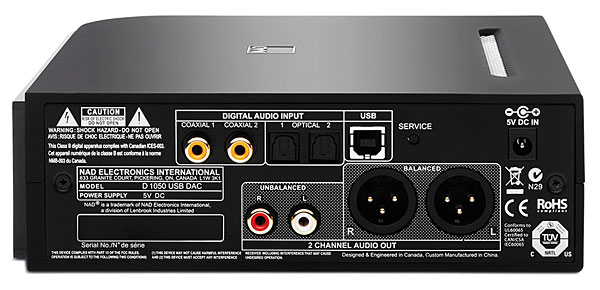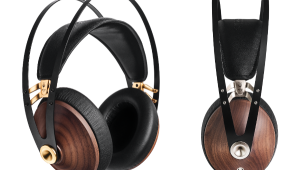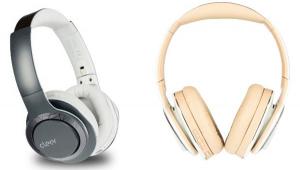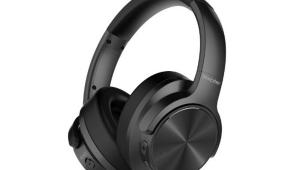NAD D 1050 DAC Headphone Amplifier

AT A GLANCE
Plus
Well-balanced sound
Space-saving footprint
XLR and RCA outputs
Minus
No data rate conversion
Incomplete sampling indicators
THE VERDICT
NAD’s D 1050 is a well-rounded DAC and headphone amp with outputs to feed a stereo preamp or receiver.
NAD’s D 1050 USB DAC, to use its official name, is one of a trio of products introduced at the same time. Like the D 7050 Direct Digital Network Amplifier ($999) and D 3020 Hybrid Digital Amplifier ($499), it includes a headphone amp and USB DAC. Unlike those two products, it doesn’t directly drive a pair of speakers—only your humble cans and the analog inputs of an audio system. However, its shape and design are similar to that of the other two products, building their digital-to-analog and preamp guts into a smaller package.
Little more than 2 inches wide, the D 1050 has a space-saving footprint that’ll be right at home on your desktop. Its front and top surfaces are gloss plastic, while its sides are a pleasing rubbery matte plastic with two subtle heat grilles near the bottom. A volume knob (for the nearby headphone minijack only) and sampling-rate indicators adorn the skinny front panel. The power and input buttons are touch- sensitive; the latter is invisible except when the unit is powered up. No remote control is provided.
Press the power button on top— it sometimes took me several tries—and the input select button lights up just in front of it. Press that, and front-panel indicators cycle through inputs and display the sampling rate of whatever file is playing, from 32 to 192 kHz. Data rate conversion isn’t performed; you hear nothing but the file’s native rate. There are no indicators for 88.2 and 176.4, but the unit plays them anyway. Each change of sampling rate is accompanied by a ticking sound.
In addition to the USB input, the back panel includes four other digital inputs, two coaxial and two optical, though there are no analog-ins. Stereo analog outputs include both RCA and XLR jacks, enabling the unit to feed a receiver or preamp. The power supply is a wall wart.
With a physical volume knob provided, you’re free to max the volume in your OS and playback software, set levels on the NAD, and start rocking. I found that easier than maxing the NAD and fumbling with the sliders in music software. The NAD ran cooler than the other two products, with its side vents barely emitting warmth.

The D 1050 had a well-balanced sound that didn’t starve or emphasize any part of the frequency spectrum. Its midrange was a little grayer and more predictable than that of the tiny Audioengine, which generally made it easier to set levels and relax into the music. The NAD had a bit more output capability than the Audio- engine, however, as you might expect of a larger device with its own power supply.
Classical music was catnip to the NAD, but it could be fussy about the company it kept. In the Beethoven symphony, it made the Sony headphones sound thin and strident, but it got a far more palatable tone out of the Sennheiser; with the Audeze, it delivered even greater smoothness and warmth, with more refinement in the strings. Yet in the Tchaikovsky waltz, the NAD suddenly fell in love with the Sony, which was again audible in the strings, and the upward trajectory in overall quality continued as Sony gave way to Sennheiser, and Sennheiser to Audeze.
In what I came to think of as the “hot” tracks, NAD’s behavior was more reserved and balanced than Audioengine’s. In the Zeppelin, it got more sense, and less sizzle, out of the blazing guitar solo, better articulating the wah-wah pedal; in the Scriabin, it was true to the glassy hardening of the piano trills, but without pushing them into even greater distortion. In the Beatles’ “Norwegian Wood,” NAD delivered the metallic hiss of George Harrison’s sitar and the cutting-edge quality of John Lennon’s vocal without either exaggerating or understating their delicate timbres.
Given a relaxed and natural recording, the NAD could sound sublime, and it was at its best with voices. In the Otis Redding track, it touched my emotions with the fragility, warmth, and humanity of the vocal. In the Bob Marley, it didn’t emphasize the vocal processing as much as the Audioengine did, and it gave the reggae rhythm section an enviable degree of natural dynamic assurance, making the hard-to-drive Sennheiser come alive.
The NAD D 1050 is a great-looking and dependably fine-sounding product that fits onto your desk without a fuss. It does its job without calling attention to itself and is a reliable guide to the varying quality of high-res audio content. It’s noteworthy that the D 1050 sells for the same as the D 3020, which adds a 30-watt stereo amp, analog inputs, a subwoofer output, and Bluetooth—but lacks the D 1050’s XLR outputs. It all boils down to this: Do you want a DAC-amp or a DAC-preamp with your headphone amp? Either way, NAD has an elegant product that fills the bill.
Read the full story, "Supercharge Your Headphones: 3 DAC/Headphone Amps Put to the Test" here
- Log in or register to post comments





































































